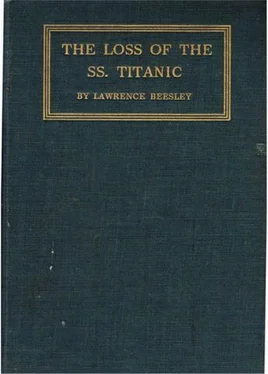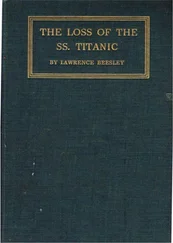Now on these two occasions when wireless telegraphy was found to be unreliable, the usefulness of the submarine bell at once becomes apparent. The Baltic could have gone unerringly to the Republic in the dense fog had the latter been fitted with a submarine emergency bell. It will perhaps be well to spend a little time describing the submarine signalling apparatus to see how this result could have been obtained: twelve anxious hours in a dense fog on a ship which was injured so badly that she subsequently foundered, is an experience which every appliance known to human invention should be enlisted to prevent.
Submarine signalling has never received that public notice which wireless telegraphy has, for the reason that it does not appeal so readily to the popular mind. That it is an absolute necessity to every ship carrying passengers—or carrying anything, for that matter—is beyond question. It is an additional safeguard that no ship can afford to be without.
There are many occasions when the atmosphere fails lamentably as a medium for carrying messages. When fog falls down, as it does sometimes in a moment, on the hundreds of ships coasting down the traffic ways round our shores—ways which are defined so easily in clear weather and with such difficulty in fogs—the hundreds of lighthouses and lightships which serve as warning beacons, and on which many millions of money have been spent, are for all practical purposes as useless to the navigator as if they had never been built: he is just as helpless as if he were back in the years before 1514, when Trinity House was granted a charter by Henry VIII “for the relief…of the shipping of this realm of England,” and began a system of lights on the shores, of which the present chain of lighthouses and lightships is the outcome.
Nor is the foghorn much better: the presence of different layers of fog and air, and their varying densities, which cause both reflection and refraction of sound, prevent the air from being a reliable medium for carrying it. Now, submarine signalling has none of these defects, for the medium is water, subject to no such variable conditions as the air. Its density is practically non variable, and sound travels through it at the rate of 4400 feet per second, without deviation or reflection.
The apparatus consists of a bell designed to ring either pneumatically from a lightship, electrically from the shore (the bell itself being a tripod at the bottom of the sea), automatically from a floating bell-buoy, or by hand from a ship or boat. The sound travels from the bell in every direction, like waves in a pond, and falls, it may be, on the side of a ship. The receiving apparatus is fixed inside the skin of the ship and consists of a small iron tank, 16 inches square and 18 inches deep. The front of the tank facing the ship’s iron skin is missing and the tank, being filled with water, is bolted to the framework and sealed firmly to the ship’s side by rubber facing. In this way a portion of the ship’s iron hull is washed by the sea on one side and water in the tank on the other. Vibrations from a bell ringing at a distance fall on the iron side, travel through, and strike on two microphones hanging in the tank. These microphones transmit the sound along wires to the chart room, where telephones convey the message to the officer on duty.
There are two of these tanks or “receivers” fitted against the ship’s side, one on the port and one on the starboard side, near the bows, and as far down below the water level as is possible. The direction of sounds coming to the microphones hanging in these tanks can be estimated by switching alternately to the port and starboard tanks. If the sound is of greater intensity on the port side, then the bell signalling is off the port bows; and similarly on the starboard side.
The ship is turned towards the sound until the same volume of sound is heard from both receivers, when the bell is known to be dead ahead. So accurate is this in practice that a trained operator can steer his ship in the densest fog directly to a lightship or any other point where a submarine bell is sending its warning beneath the sea. It must be repeated that the medium in which these signals are transmitted is a constant one, not subject to any of the limitations and variations imposed on the atmosphere and the ether as media for the transmission of light, blasts of a foghorn, and wireless vibrations. At present the chief use of submarine signalling is from the shore or a lightship to ships at sea, and not from ship to ship or from ship to the shore: in other words ships carry only receiving apparatus, and lighthouses and lightships use only signalling apparatus. Some of the lighthouses and lightships on our coasts already have these submarine bells in addition to their lights, and in bad weather the bells send out their messages to warn ships of their proximity to a danger point. This invention enables ships to pick up the sound of bell after bell on a coast and run along it in the densest fog almost as well as in daylight; passenger steamers coming into port do not have to wander about in the fog, groping their way blindly into harbour. By having a code of rings, and judging by the intensity of the sound, it is possible to tell almost exactly where a ship is in relation to the coast or to some lightship. The British Admiralty report in 1906 said: “If the lightships round the coast were fitted with submarine bells, it would be possible for ships fitted with receiving apparatus to navigate in fog with almost as great certainty as in clear weather.” And the following remark of a captain engaged in coast service is instructive. He had been asked to cut down expenses by omitting the submarine signalling apparatus, but replied: “I would rather take out the wireless. That only enables me to tell other people where I am. The submarine signal enables me to find out where I am myself.”
The range of the apparatus is not so wide as that of wireless telegraphy, varying from 10 to 15 miles for a large ship (although instances of 20 to 30 are on record), and from 3 to 8 miles for a small ship.
At present the receiving apparatus is fixed on only some 650 steamers of the merchant marine, these being mostly the first-class passenger liners. There is no question that it should be installed, along with wireless apparatus, on every ship of over 1000 tons gross tonnage. Equally important is the provision of signalling apparatus on board ships: it is obviously just as necessary to transmit a signal as to receive one; but at present the sending of signals from ships has not been perfected. The invention of signal-transmitting apparatus to be used while the ship is under way is as yet in the experimental stage; but while she is at rest a bell similar to those used by lighthouses can be sunk over her side and rung by hand with exactly the same effect. But liners are not provided with them (they cost only 60 Pounds!). As mentioned before, with another 60 Pounds spent on the Republic’s equipment, the Baltic could have picked up her bell and steered direct to her—just as they both heard the bell of Nantucket Lightship. Again, if the Titanic had been provided with a bell and the Californian with receiving apparatus,—neither of them was,—the officer on the bridge could have heard the signals from the telephones near.
A smaller size for use in lifeboats is provided, and would be heard by receiving apparatus for approximately five miles. If we had hung one of these bells over the side of the lifeboats afloat that night we should have been free from the anxiety of being run down as we lay across the Carpathia’s path, without a light. Or if we had gone adrift in a dense fog and wandered miles apart from each other on the sea (as we inevitably should have done), the Carpathia could still have picked up each boat individually by means of the bell signal.
Читать дальше












